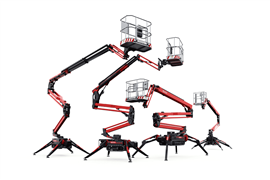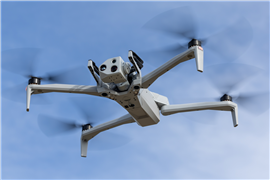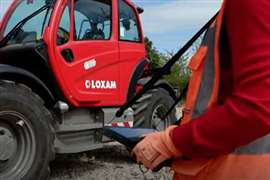The next big thing in access: India
07 July 2023
India is destined for huge growth in its access sector, and it may come sooner than some might think. AI gets a full view of the markets from two of its up and coming rental companies.
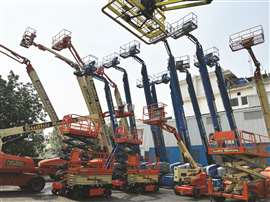 One of Sudhir Power’s rental yards. (PHOTO: Sudhir Rentals)
One of Sudhir Power’s rental yards. (PHOTO: Sudhir Rentals)
Much has been said about the opportunities in India over the years, considering the country has a population of 1.4 billion yet a tiny MEWP population in comparison.
It has always seemed probable that one day the number of units would match the larger markets in the world. However, up until now it has been more of an ambition than a direction of travel.
Over the last couple of years, however, there has been a shift in that view and there is now a firm belief India is in the cusp of major growth.
Estimates of the number of MEWPs working in India currently range between 11,000 – 15,000, with the overwhelming majority being older used equipment.
Ankit Bhati, the general manager for Sudhir Rentals’ Inda business, explains how the country has always been a second-hand MEWP market, and a very price conscious one at that. Currently the average MEWP in India was manufactured between 2008 and 2015, says Bhati. “Five years ago it was worse and it’s getting better every year.
“And in 2023 I see people buying new machines.”
As Ankit goes on to explain, the small number of units in India has a lot to do with the fact the market is young, “I would say people have been using AWPs in India for the last 20 years but the actual growth only started around eight years ago.
“Before that people were using them in ones or twos, but with the increasing amount of infrastructure and increasing number of multi-nationals coming to India, they have given a larger push for applications and the use of this product.”
Top access equipment rental companies in India
Sudhir Power is an example of a company that saw the future of the MEWP sector in India. Sudhir is in the 50th year of business. Some 20 years ago the company started its power generation and distribution wing, which, for example, produces around 80,000 generators every year.
The rental business was formed in 2014 and includes a range of products such as generators, material handling equipment and MEWPs, as well as other items like air conditioning units and chillers. It is also a distributor for JLG and Genie in the country.
Sudhir has more than 800 units in its India fleet and around 2,500 units in total across India and its other markets UAE and Saudi Arabia. In addition to that Sudhir acquired UK rental company Star Platforms in recent years, which has a further 3,000 units in its fleet.
Ankit adds, “In five to eight years the market in India has doubled. That’s a good sign but there are lots of places in India where the acceptability is less.”
Sudhir is one of around 10-12 MEWP rental companies based in India that could be described as serious players in the market with a commitment to developing the product and associated services.
Another is RentEase International, which started up in India in 2017 with a vision at the time of investing in new electric scissors and acquired equipment from the likes of Haulotte in their hundreds.
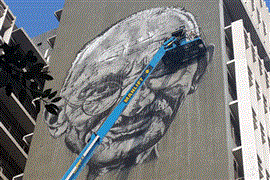
Manlift, part of the Netherlands-based access equipment rental specialist Riwal group, is the largest access rental company in India, and has ben integral in the growth of the MEWP market there. |
Since the Covid pandemic there has been a change in direction at the company and international growth which has seen it move into used equipment sales and widen its new equipment distribution offering by becoming an exclusive dealer for Niftylift and Scanclimber in India.
Its new entities in Belgium and the USA, will see an office in the latter opening soon as a trading and sourcing centre for its used equipment division.
Developing MEWP markets
All that is in addition to a new rental branch in Bangladesh, which already has around 120 MEWPs in its fleet.
This next step into developing even younger MEWP markets such as Bangladesh are clear signs of where the access industry is ultimately heading – towards a truly mature international market.
Vipul Tulsian, managing partner at RentEase, said, “Covid was a speed breaker in our journey. After Covid we had time to think and how to reach our vision.
“We realised things should be a bit different, so we increased our verticals (boom lifts), and took ownership of distribution and started used machines sales.
“And we have grown in a more mature way and kept our strategy clear and focused.”
On the subject of its used equipment wing, comments, “Where we have brought machines from Middle East and Southeast Asia, etc. this is something the banking system doesn’t allow in India so we are doing that with our other companies.”
Demonstrating India’s relative immaturity as far as MEWPs are concerned is the fact that 90% of the fleet in the country is comprised of boom lifts, which ultimately got in the way of RentEase’s origanal strategy to focus on electric scissors.
“We wanted to start developing electric scissors and new equipment but the size of the country and numbers in the [AWP] population didn’t match so we thought we needed to do something different.
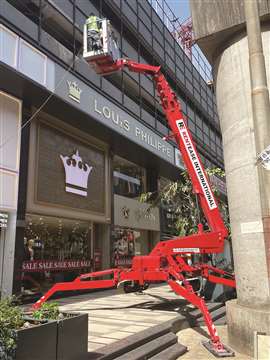 RentEase is introducing spider lift rental to India. (PHOTO: RentEase)
RentEase is introducing spider lift rental to India. (PHOTO: RentEase)
Nevertheless, after RentEase started its move into slab scissors, it saw electric scissors becoming more prevalent in India. And the company recently set up a spider lift division and invested in 25 spider units.
“We want to create that market. At the moment facilities usually buy their own and very small numbers are available for rental.” The company has also taken on the distribution of spider lifts from Italy-based Easy Lift.
India: Scissor lift market
According to Ankit the scissor lift market is set to increase substantially thanks to demands from major companies from outside India that are expanding into the country, and Sudhir Power intends to take advantage of that.
“Very recently a couple of good companies like Samsung and Kia have said only scissors are to be used in their plants in India.
“With that kind of manufacturing mindset there are now projects in India with more than 300 scissors used in the same place for more than six months.”
But, Ankit adds, there are still relatively few examples of this. “Slowly and steadily, we are getting enquires for 12m or 14m jobs, where scaffolding was used, and are now getting converted to a scissor lift.
“It is increasing and I am confident it will be getting better and better every year.”
While the country has a long way to maturity, OEMs are lining up to offer their products to the market. All the major scissor and boom manufacturers are now present in India, says Ankit.
That includes the established companies from Europe and North America, as well as the more recently founded China-based manufacturers.
“There are eight to 10 manufacturers in India selling and servicing their equipment. When we started there were was only Genie and JLG.
“There have been a lot of transitions from 2015 to 2023, and we feel the market size for new machines is still so small but the competition is becoming more complex.”
This comes from a company that claims to have been the first rental company in India to have bought new equipment to the country when it invested in 100 units in 2016.
The future of rental equipment
There are between 12 and 15 major rental companies in India with hundreds of units in their fleets. Then there are the dozens of smaller localised companies, possibly around 100, that can have as few as two units in their fleets.
As Tulsian explains, 80% of India’s MEWP fleet is operated by the 50 largest rental companies.
But that is likely to change as the market starts to ramp up and the market becomes ‘educated’. “People are seeing the advantages of new machines and buying newer machines. And if they buy used they now buy less than 10-year-old equipment. Over last eight months used machines are less available”.
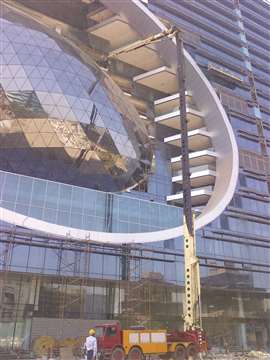 Sudhir truck mount at work. (PHOTO: Sudhir Rentals)
Sudhir truck mount at work. (PHOTO: Sudhir Rentals)
This is partly due to the widely reported supply chain constraints and long lead times, which have led to fewer used machines coming into the Indian market as they are snapped up in the countries of origin.
The influx of Chinese aerial platform brands
“Many big rental companies now look for the opportunity to go for new machines. And that is where the Chinese manufacturers come in.
“In the past we had it in mind that the quality [of Chinese MEWPs} was not as good. Now it is good and the big reputable names are utilizing Chinese manufacturing. They are filling the gap that delivery and supply chain demand and taking advantage of that.”
As Ankit adds, Chinese companies have become much stronger. This, he says, is “Primarily because of pricing and India is a price sensitive market.
Also, adds Ankit, “Most of these companies are in the crane business and that they have a presence in India already, so they have leverage on that. Chinese companies are leading the market, that’s for sure.”
While there is no sign of new safety laws on the horizon in India, the adoption of MEWPs in the country will be forced by investment from mature countries.
MEWP safety regulations in India
Gradually, foreign investment is coming in. With that comes safety guidelines.
Tulsian adds, “If we compare it to three years ago, before Covid, there is a big difference now. Foreign investment now brings safety standards, as the sub-contractors understand the importance of safety, so when they go onto the next site they use those guidelines.”
This will be helped by the Indian government’s target of a $5 trillion economy by 2030, driven by mega projects across the nation from industry to transport, including high-speed rail and a plan for more than 100 new airports.
This will mean the MEWP population will grow by 20% each year over the next five years.
On top of this, Ankit says the country now has to solve two major factors, the lack of safety regulations and the lack of skilled manpower, then the MEWP market in India “will beat any other in the world.”
Why the demand for aerial platform operators is rising
One dynamic that is different to nearly all other access equipment markets is that all MEWPs on rent in India are supplied with an operator. “India is the only country where we have to provide an operator with the machine when it is out on rent.
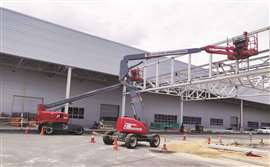 RentEase Units carry out steel erection work. (PHOTO: RentEase)
RentEase Units carry out steel erection work. (PHOTO: RentEase)
Therefore, if a company increases its fleet from 800 units to 1,500, it also has to find almost the same level of extra labour. This is particularly challenging as utilisation is up at around 80% in India. “It is a very tough task to manage this to scale,” says Ankit.
As this would suggest, it is not the cost of labour that is the issue, unlike in other countries. In India, the cost of labour is relatively cheap, which is another reason for MEWP market growth being held up.
India’s lack of MEWP training infrastructure
An additional problem is the issue of training all the MEWP operators supplied with the equipment up to an acceptable standard.
“There is no formal training infrastructure in India. We are not able to train the number of operators for the number of units that are coming in this year,” says Ankit.
Apart from this, Ankit adds, “It is high time that India introduces stringent safety norms.”
Rental rates, on the other hand, are relatively strong. “From the end of 2021 there was a shortfall of machines and rental rates are now improving,”
Since 2017-2018, and before the onset of the Covid pandemic, they are up 25%. Having said that, other costs have gone up too. Ankit concludes, “Rental companies realised if they didn’t increase prices, they would be hit hard. Customers were not happy but now the market has settled.”
STAY CONNECTED



Receive the information you need when you need it through our world-leading magazines, newsletters and daily briefings.
CONNECT WITH THE TEAM











